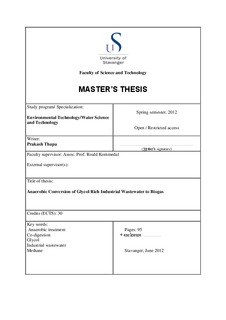| dc.contributor.author | Thapa, Prakash | |
| dc.date.accessioned | 2014-02-06T08:44:44Z | |
| dc.date.available | 2014-02-06T08:44:44Z | |
| dc.date.issued | 2012 | |
| dc.identifier.uri | http://hdl.handle.net/11250/182590 | |
| dc.description | Master's thesis in Environmental Technology | no_NO |
| dc.description.abstract | Oil and gas industries generate large volumes of wastewater during exploitation and processing of oil and gas. Industrial wastewater contains glycols along with other organic and inorganic compounds. It is essential to treat such wastewaters before discharge to the environment as these can have significant impacts on the environment. This research work has attempted to evaluate the feasibility of anaerobic treatment of glycol rich industrial wastewater for biogas production.
In the present study, three different laboratory scale experiments were conducted. The method used was the comparative assessments of results from two semi-continuous flow stirred tank reactors operating at same environmental conditions. One reactor was loaded with yeast extract solution while other reactor was operated with equal volumes of solution containing 50% COD load from Mono-ethylene glycol (MEG) while 50% COD load from co-substrate solution. The glycol solution used in the study was high strength laboratory manufactured MEG solution with COD of approx. 29,400 mg/L and 33,900 mg/L in experiments two and three respectively. The sludge collected from anaerobic digester of IVAR wastewater treatment plant was used as the source of microbes for anaerobic digestion.
Methane yields corresponding to the peak gas productions of 211 mL/g COD and 299 mL/g COD were determined from the glycol solution in the experiments two and three respectively even at partial inhibition states. There was a rapid drop in alkalinity and pH after introduction of glycol in the reactors leading to failure of the anaerobic process in experiment 2. pH inhibition was observed in experiment 3 as well but alkalinity was added this time to control pH. The results show that pH inhibition due to insufficient alkalinity in the reactor is most likely the prominent cause for failure of the process. Apart from this, analysis of bulk phase samples indicates that high organic loading and short solid retention time were most likely responsible for accumulation of volatile fatty acids causing pH reductions. With necessary improvements in the overall design and frequent monitoring and controlling of important parameters such as temperature, pH, alkalinity, nutrients, etc., it seems that reactor performance can be enhanced. From this study, it can be concluded that it is feasible to convert glycol rich industrial wastewater to biogas. However, due to lack of alkalinity production during fermentation and potential nutrient limitation, co-digestion with a complex substrate/sludge seems to be required for long term stable anaerobic digester performance. | no_NO |
| dc.language.iso | eng | no_NO |
| dc.publisher | University of Stavanger, Norway | no_NO |
| dc.relation.ispartofseries | Masteroppgave/UIS-TN-IMN/2012; | |
| dc.subject | environmental technology | no_NO |
| dc.subject | anaerobic treatment | no_NO |
| dc.subject | industrial wastewater | no_NO |
| dc.subject | teknisk miljøvern | |
| dc.title | Anaerobic Conversion of Glycol Rich Industrial Wastewater to BiogasAnaerobic Conversion of Glycol Rich Industrial Wastewater to Biogas | no_NO |
| dc.type | Master thesis | no_NO |
| dc.subject.nsi | VDP::Technology: 500::Environmental engineering: 610 | no_NO |
